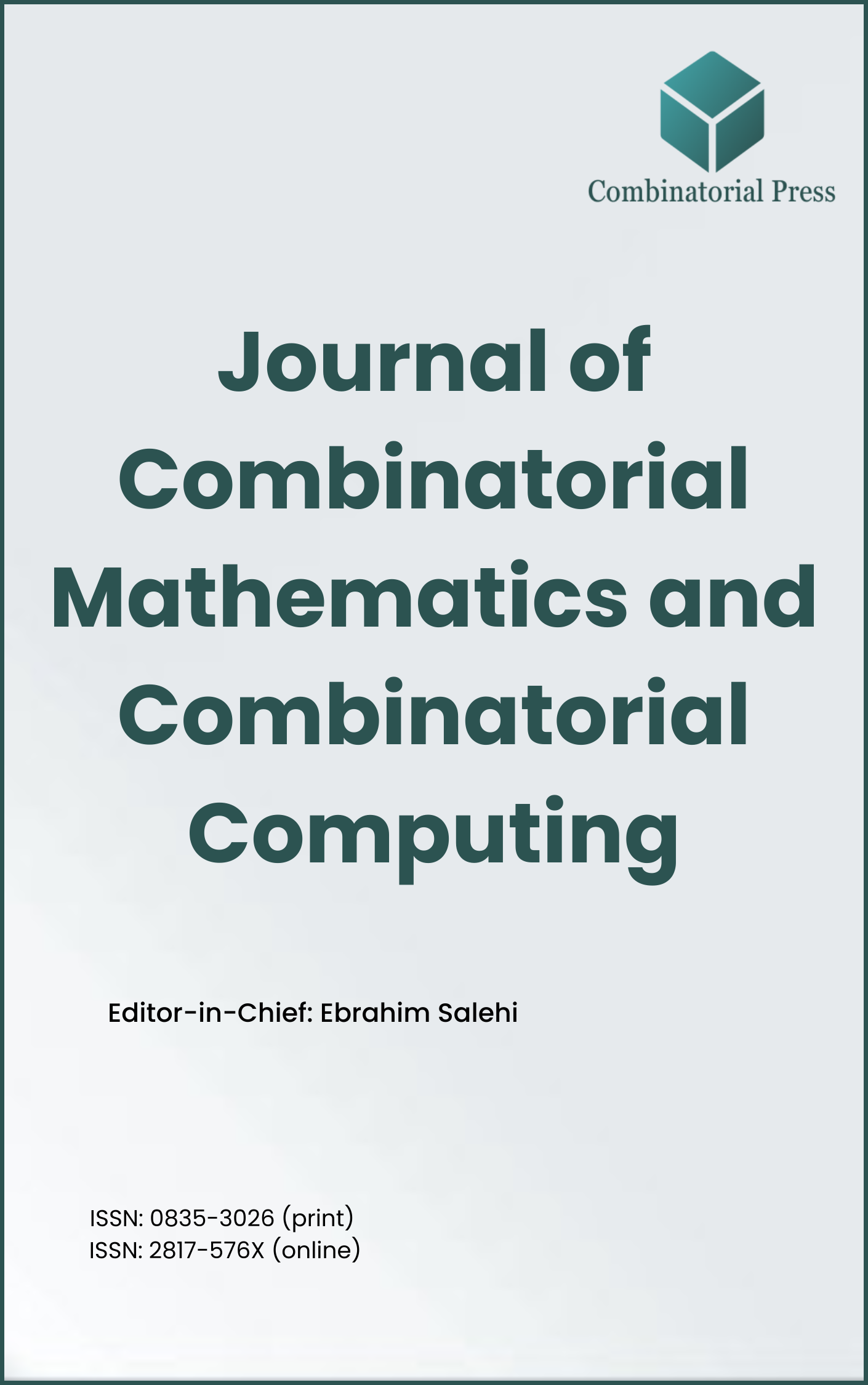
Journal of Combinatorial Mathematics and Combinatorial Computing
ISSN: 0835-3026 (print) 2817-576X (online)
The Journal of Combinatorial Mathematics and Combinatorial Computing (JCMCC) embarked on its publishing journey in April 1987. From 2024 onward, it publishes four volumes per year in March, June, September and December. JCMCC has gained recognition and visibility in the academic community and is indexed in renowned databases such as MathSciNet, Zentralblatt, Engineering Village and Scopus. The scope of the journal includes; Combinatorial Mathematics, Combinatorial Computing, Artificial Intelligence and applications of Artificial Intelligence in various files.
- Research article
- Full Text
- Journal of Combinatorial Mathematics and Combinatorial Computing
- Volume 005
- Pages: 14-22
- Published: 30/04/1989
A graph \(G\) is \([a, b]\)-covered if each edge of \(G\) belongs to an \([a, b]\)-factor. Here, a necessary and sufficient condition for a graph to be \([a, b]\)-covered is given, and it is shown that an \([m, n]\)-graph is \([a, b]\)-covered if \(bm – na \geq 2(n-b)\) and \(0 \leq a < b \leq n\).
- Research article
- Full Text
- Journal of Combinatorial Mathematics and Combinatorial Computing
- Volume 005
- Pages: 3-13
- Published: 30/04/1989
- Research article
- Full Text
- Journal of Combinatorial Mathematics and Combinatorial Computing
- Volume 004
- Pages: 213-222
- Published: 31/10/1988
The chromatic polynomial captures a good deal of combinatorial information about a graph, describing its acyclic orientations, its all-terminal reliability, its spanning trees, as well as its colorings. Several methods for computing the chromatic polynomial of a graph G construct a computation tree for G whose leaves are “simple” base graphs for which the chromatic polynomial is readily found. Previously studied methods involved base graphs which are complete graphs, completely disconnected graphs, forests, and trees. In this paper, we consider chordal graphs as base graphs. Algorithms for computing the chromatic polynomial based on these concepts are developed, and computational results are presented.
- Research article
- Full Text
- Journal of Combinatorial Mathematics and Combinatorial Computing
- Volume 004
- Pages: 207-212
- Published: 31/10/1988
Using several computer algorithms, we calculate some values and bounds for the function \(e(3,k,n)\), the minimum number of edges in a triangle-free graph on \(n\) vertices with no independent set of size \(k\). As a consequence, the following new upper bounds for the classical two-color Ramsey numbers are obtained:
\(R(3,10) \leq 43\), \(\quad\)
\(R(3,11) \leq 51\), \(\quad\)
\(R(3,12) \leq 60\), \(\quad\)
\(R(3,13) \leq 69\) \(\quad\) and
\(R(3,14) \leq 78\).
- Research article
- Full Text
- Journal of Combinatorial Mathematics and Combinatorial Computing
- Volume 004
- Pages: 189-206
- Published: 31/10/1988
- Research article
- Full Text
- Journal of Combinatorial Mathematics and Combinatorial Computing
- Volume 004
- Pages: 155-188
- Published: 30/04/1988
We give some results on the excess of Hadamard matrices. We provide a list for Hadamard matrices of order \(\leq 1000\) of the smallest upper bounds known for the excess for each order. A construction is indicated for the maximal known excess.
- Research article
- Full Text
- Journal of Combinatorial Mathematics and Combinatorial Computing
- Volume 004
- Pages: 133-154
- Published: 31/10/1988
The type of a \(3\)-factorization of \(3K_{2n}\) is the pair \((t,s)\), where \(t\) is the number of doubly repeated edges in \(3\)-factors, and \(\binom{n}{2} – s\) is the number of triply repeated edges in \(3\)-factors. We determine the spectrum of types of \(3\)-factorizations of \(3K_{2n}\), for all \(n \geq 6\); for each \(n \geq 6\), there are \(43\) pairs \((t,s)\) meeting numerical conditions which are not types and all others are types. These \(3\)-factorizations lead to threefold triple systems of different types.
- Research article
- Full Text
- Journal of Combinatorial Mathematics and Combinatorial Computing
- Volume 004
- Pages: 123-132
- Published: 31/10/1988
Let \(V\) be a finite set of \(v\) elements. A covering of the pairs of \(V\) by \(k\)-subsets is a family \(F\) of \(k\)-subsets of \(V\), called blocks, such that every pair in \(V\) occurs in at least one member of \(F\). For fixed \(v\), and \(k\), the covering problem is to determine the number of blocks of any minimum (as opposed to minimal) covering. Denote the number of blocks in any such minimum covering by \(C(2,k,v)\). Let \(B(2,5,v) = \lceil v\lceil{(v-1)/4}\rceil/{5}\rceil\). In this paper, improved results for \(C(2,5,v)\) are provided for the case \(v \equiv 1\) \(\quad\) or \(\quad\) \(2 \;(mod\;{4})\).\(\quad\) For \(\quad\) \(v \equiv 2\; (mod\;{4})\), \(\quad\) it \(\quad\) is \(\quad\) shown \(\quad\) that \(C(2,5,270) = B(2,5,270)\) and \(C(2,5,274) = B(2,5,274)\), establishing the fact that if \(v \geq 6\) and \(v \equiv 2\;mod\;4\), then \(C(2,5,v) = B(2,5,v)\). In addition, it is shown that if \(v \equiv 13\;(mod\;{20})\), then \(C(2,5,v) = B(2,5,v)\) for all but \(15\) possible exceptions, and if \(v \equiv 17\;(mod\;{20})\), then \(C(2,5,v) = B(2,5,v)\) for all but \(17\) possible exceptions.
- Research article
- Full Text
- Journal of Combinatorial Mathematics and Combinatorial Computing
- Volume 004
- Pages: 115-122
- Published: 31/10/1988
- Research article
- Full Text
- Journal of Combinatorial Mathematics and Combinatorial Computing
- Volume 004
- Pages: 97-114
- Published: 31/10/1988
The structure and the hamiltonicity of vertex-transitive graphs of order \(qp\), where \(q\) and \(p\) are distinct primes, are studied. It is proved that if \(q < p\) and \(\text{p} \not\equiv 1 \pmod{\text{q}}\) and \(G\) is a vertex-transitive graph of order \(qp\) such that \({Aut}G\) contains an imprimitive subgroup, then either \(G\) is a circulant or \(V(G)\) partitions into \(p\) subsets of cardinality \(q\) such that there exists a perfect matching between any two of them. Partial results are obtained for \(\text{p} \equiv 1 \pmod{\text{q}}\). Moreover, it is proved that every connected vertex-transitive graph of order \(3p\) is hamiltonian.





